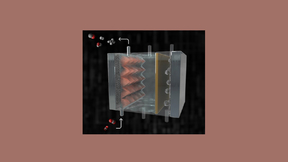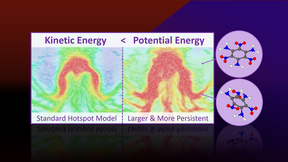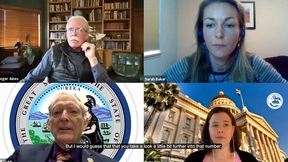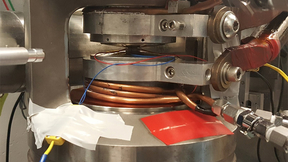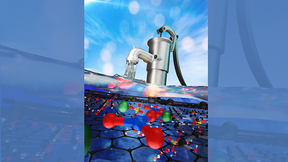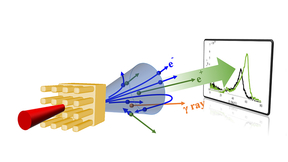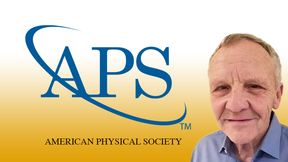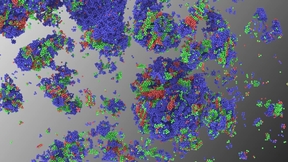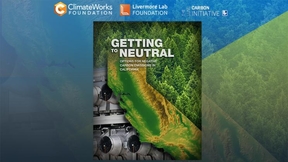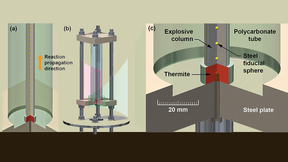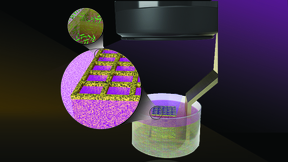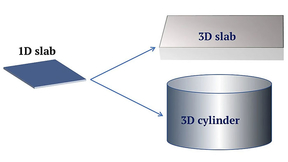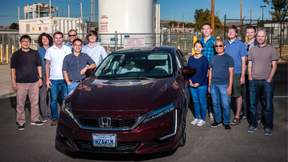Back
Advanced Materials and Manufacturing
Enhancing the mechanical performance of aluminum alloys
Laser powder bed fusion (LPBF) is a prominent additive manufacturing (AM) process that fuses thin layers of metal powder to underlying layers using laser melting in a sequential process. However, the high cooling rates and peak surface temperatures of the LPBF process can cause solidification defects in lightweight materials such as aluminum (Al) alloys, which have poor…
3D-printable gas diffusion layers promise improved performance in electrochemical reduction of CO2
Using carbon dioxide (CO2) emissions to create value-added products is an attractive approach to reduce net greenhouse gas emissions. Processes such as the electrochemical reduction of CO2 to ethylene and ethanol offer a pathway to producing commodity chemicals without fossil fuels when they are powered using low-carbon electricity. Gas diffusion electrode (GDE) assemblies…
Research uncovers missing physics in explosive hotspots
Research conducted on Lawrence Livermore National Laboratory’s (LLNL) supercomputer Quartz highlights findings made by scientists that reveal a missing aspect of the physics of hotspots in TATB (1,3,5-trimamino-2,4,6-trinitrobenzene) and other explosives. Hotspots are localized regions of elevated temperature that form from shock-induced collapse of microstructural…
No miracles required: Scientists, industry experts agree California’s carbon capture and storage can be a reality
When it comes to California implementing a carbon capture and storage program to reach the state’s goal of carbon neutrality by 2045, nothing too newfangled needs to take place. During a forum titled “Carbon Capture and Sequestration in California: Regional Insights and Community Attitudes,” a group of scientists, California policymakers and industry leaders came together…
Research identifies a pressure-induced increase in efficiency, phase transition of thermoelectric materials
Researchers have shown how applying pressure to a specific thermoelectric material, TiNiSn, increases its efficiency and leads to a structural phase transition. Thermoelectric materials are materials that can provide energy without the need for mechanical parts by converting heat energy into electrical energy. Thus, research aimed at these materials can identify new, more…
Tailored Water Treatment Ready to Clean Up
Livermore scientists working alongside Stanford University researchers have made headway toward a new generation of tailored, reversible water treatment.
Doubling creation of antimatter using same laser energy
Lawrence Livermore National Laboratory (LLNL) scientists have achieved a near 100 percent increase in the amount of antimatter created in the laboratory. Using targets with micro-structures on the laser interface, the team shot a high-intensity laser through them and saw a 100 percent increase in the amount of antimatter (also known as positrons). The research appears in…
Tarver honored with American Physical Society award
Craig Tarver, a Lawrence Livermore National Laboratory (LLNL) retiree and consultant to the Lab’s Energetic Materials Center, has been honored with the American Physical Society’s (APS) 2021 George E. Duvall Shock Compression Science Award for “theoretical advancement of the understanding of shock-driven reactions and detonation in condensed phase explosives.” Since 1987,…
LLNL scientists discover a new way that metals freeze at extreme conditions
Since the dawn of civilization, metallurgy has determined the fate of powerful cities, states and empires. Blacksmiths have harnessed the power of heat to melt simple metals that would then be cast into hard, sharp and shiny alloys. Varying process conditions, such as rate of cooling and composition, can lead to new materials with dramatically different mechanical…
Moving to carbon neutrality: one year later
One year after publishing the groundbreaking "Getting to Neutral: Options for Negative Carbon Emissions in California," Lawrence Livermore National Laboratory (LLNL) has become a trusted adviser in the discussion of how to remove carbon dioxide from the air. In the report, LLNL scientists identified a robust suite of technologies to help California clear the last hurdle…
Research on transition phenomena to aid in improving safety of explosives
On Aug. 4, 2020, a massive explosion rocked Lebanon’s capital of Beirut, sending shockwaves through the city and shattering windows, reducing some buildings to rubble and killing at least 200 people. Officials have since traced the blast to a stockpile of more than 2,500 tons of confiscated ammonium nitrate stored in a port warehouse. While the official investigation is…
Lab 3D-prints microbes to enhance biomaterials
Lawrence Livermore National Laboratory (LLNL) scientists have developed a new method for 3D printing living microbes in controlled patterns, expanding the potential for using engineered bacteria to recover rare-earth metals, clean wastewater, detect uranium and more. Through a novel technique that uses light and bacteria-infused resin to produce 3D-patterned microbes, the…
Formulating polymers that enhance explosives performance
The design of new explosive and propellant formulations, in compliance with insensitive munitions directives, require that performance be increased, while concurrently increasing stability and safety. Additional requirements include higher density, reduced environmental impact, improved mechanical properties, and extended service life. The combination of high explosives …
Tarver honored with APS shock compression science award
Craig Tarver (MSD) has been honored with the American Physical Society’s (APS’s) 2021 George E. Duvall Shock Compression Science Award for “theoretical advancement of the understanding of shock-driven reactions and detonation in condensed phase explosives.” Since 1968, the award—the highest offered by APS in shock compression science—has biennially recognized contributions…
Thin sample experiments help predict moisture sorption in larger samples
Over time, moisture can change a material’s physical and chemical properties, altering its performance and the performance of other materials in close proximity. This change in performance is especially a concern when considering materials used in the food, packaging, medicine, electronics, and construction industries. Understanding the material moisture capacity and…
Pitz elected fellow of Society of Automotive Engineers
Physicist Bill Pitz (MSD) has been elected as fellow of the Society of Automotive Engineers (SAE). Bill studies combustion phenomenon in various types of engines. The fellow grade of membership was established by the society in 1975 to honor and recognize important engineering, scientific, and leadership achievements that enhance the status of SAE’s contributions to the…
Using machine learning techniques to extract nanomaterial information from SEM images
Quantitative analysis of scanning electron microscopy (SEM) images is important for understanding the structural and morphological variations of nanomaterials. Information obtained from SEM images—such as the particle size, size distribution, and morphology—provide technical and scientific insights into the process of nanomaterial synthesis, fabrication, and manufacturing…
LLNL hydrogen researchers win technical program award
DOE’s Hydrogen and Fuel Cell Technology Office (HFTO) selected Brandon Wood and Tadashi Ogitsu (both MSD) for the 2020 Technical Program Area Award in Hydrogen Fuel R&D. This award recognizes the computational materials science team at LLNL for their exceptional support to the HydroGEN Advanced Water Splitting Materials and Hydrogen Materials Advanced Research…
Lab teams earn DOE Secretary Achievement Awards
Lawrence Livermore National Laboratory (LLNL) employees, participating in 10 project teams, recently earned Department of Energy (DOE) Secretary Achievement Awards. Representing some of the highest internal, non-monetary recognition that DOE employees and contractors can receive, these awards recognize DOE employees and contractors for their service and contributions to…
NIF conducts first-ever shot with explosives
The first-ever shot to study a high explosive sample was recently conducted at the National Ignition Facility (NIF), the world’s most energetic laser. The results from the shot included novel data that will help researchers unlock the mysteries of high-explosive (HE) chemistry and position Lawrence Livermore National Laboratory (LLNL) to continue its legacy as a leader in…



